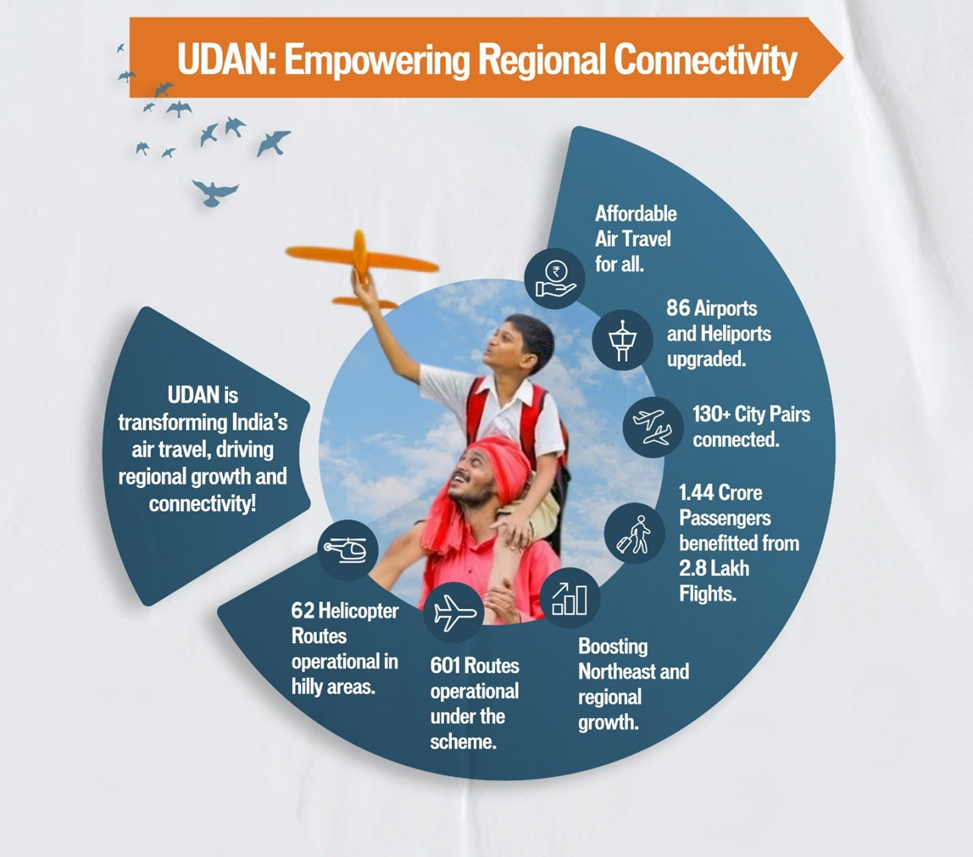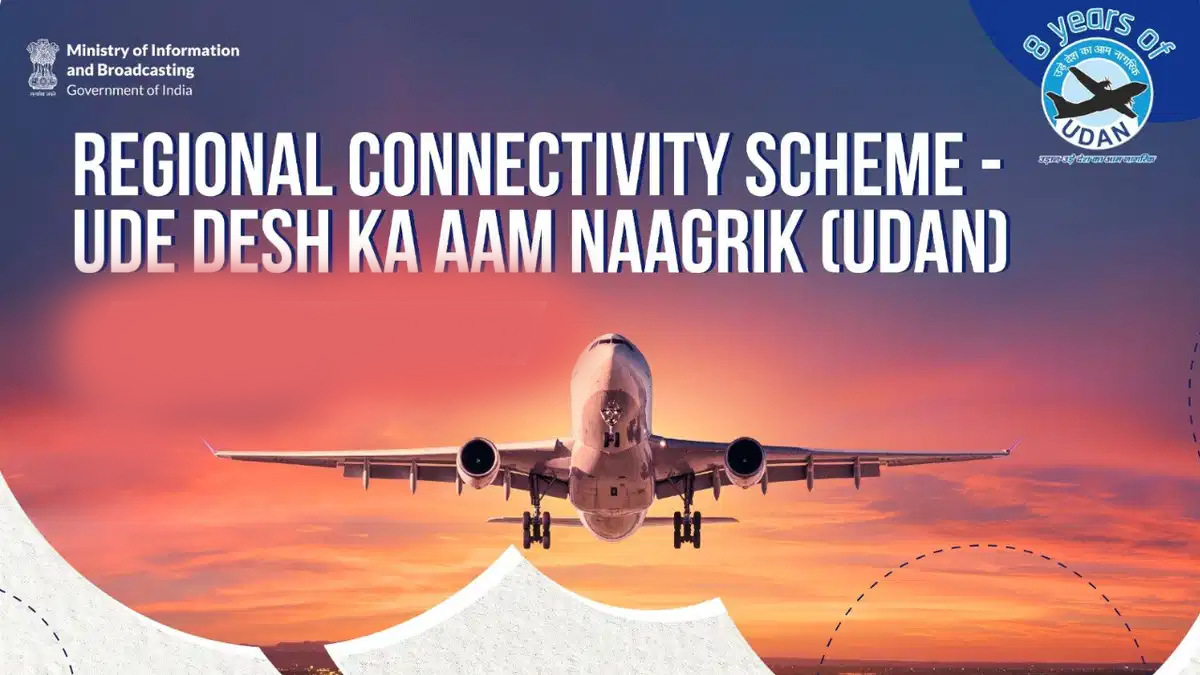On October 20, 2024, Prime Minister Shri Narendra Modi inaugurated three newly developed airports in Saharanpur (Uttar Pradesh), Rewa (Madhya Pradesh), and Ambikapur (Chhattisgarh) under the Regional Connectivity Scheme (RCS) - UDAN (Ude Desh Ka Aam Nagrik). This event marks a significant milestone for India's aviation sector, particularly in promoting connectivity to remote and underserved regions. The inauguration took place in Varanasi, Uttar Pradesh, and these airports will soon begin operations under the UDAN scheme, which has already connected several previously unserved and underserved regions across the country.
The UDAN Scheme: A Brief Overview
· The Regional Connectivity Scheme (RCS) - UDAN was launched on October 21, 2016, as a critical component of the National Civil Aviation Policy (NCAP) 2016. UDAN was designed to enhance regional air connectivity by making air travel affordable for the general public, particularly in regions where air services were either limited or non-existent.
· The scheme’s primary objective is to democratize air travel and make it accessible to the common man, encapsulated by Prime Minister Modi’s vision of "seeing people wearing slippers boarding planes."
· Since its inception, the UDAN scheme has made substantial progress. The first UDAN flight took off on April 27, 2017, connecting Shimla to Delhi, and since then, over 144 lakh (14.4 million) passengers have benefitted from the scheme. To date, more than 601 routes have been operationalized, and 86 aerodromes (including airports, heliports, and water aerodromes) have been made functional, connecting even the remotest parts of India.

Evolution of the UDAN Scheme: Different Phases and Versions
The UDAN scheme has undergone multiple phases of development since its inception:
1. UDAN 1.0 (2017): In the first phase, five airline companies were awarded 128 flight routes connecting 70 airports, including 36 newly operational airports.
2. UDAN 2.0 (2018): In this phase, 73 underserved and unserved airports were included, and helipads were connected for the first time.
3. UDAN 3.0 (2019): This phase, in collaboration with the Ministry of Tourism, introduced tourism routes, connecting popular tourist destinations, and expanded services in the North-East region. It also added seaplanes for water aerodrome connectivity.
4. UDAN 4.0 (2020): The focus shifted to North-Eastern regions, hilly states, and islands. Helicopter and seaplane operations were further expanded.
5. UDAN 5.0 (2023): The latest phase, UDAN 5.0, removed the earlier restriction of a 600 km flight distance cap. It prioritized routes that could be operationalized quickly, with airlines required to commence operations within four months of receiving route awards.
Further enhancements included UDAN 5.1, specifically designed for helicopter routes, and UDAN 5.2, which targeted small aircraft operations. The ongoing versions UDAN 5.3 and 5.4 continue to focus on re-operationalizing discontinued routes and expanding regional connectivity.
Significance of the scheme:
The UDAN scheme (Ude Desh Ka Aam Nagrik) significantly impacts India's aviation sector and regional development. Here are the key points:
1. Boosting Regional Connectivity: The scheme addresses the gap in regional connectivity by linking remote areas to urban hubs. It operationalizes smaller airports and introduces new routes, bringing regions like Tezu (Arunachal Pradesh), Darbhanga (Bihar), and Jharsuguda (Odisha) closer to major cities, thus enhancing access to services and markets.
2. Economic Impact and Employment Generation: Developing new airports stimulates trade, tourism, and local businesses, contributing to regional economic growth. The construction and maintenance of these airports create direct jobs in aviation and indirect jobs in hospitality, tourism, and local commerce.
3. Promoting Tourism: UDAN has significantly boosted tourism, especially in less accessible regions. Under UDAN 3.0, new routes connect culturally rich locations like Khajuraho and Amritsar, while improving access to the North-East, known for its natural beauty and cultural heritage. Airports in Pasighat, Ziro, and Hollongi are examples of this initiative enhancing the tourism sector.
4. Support for Emerging Airlines: The scheme creates a favorable environment for new airlines like Flybig and Star Air to thrive. These regional airlines benefit from government support, including Viability Gap Funding (VGF), reduced taxes on aviation turbine fuel (ATF), and exemptions on landing and parking charges.
5. Environmental and Social Impact: RCS-UDAN promotes environmental sustainability by encouraging regional flights, which are shorter and consume less fuel. It also increases air travel accessibility for a broader population, fulfilling Prime Minister Modi's vision of inclusivity in the aviation sector.

Fueling Growth in the Aviation Industry:
The UDAN scheme has significantly transformed the Indian aviation landscape, enhancing connectivity and revitalizing the civil aviation industry.
· Operational Routes: Around 601 routes, including helicopter routes, have been operationalized, connecting various states and Union Territories. Notably, about 28% of these routes serve remote areas, improving accessibility in challenging terrains.
· New Airlines: The RCS-UDAN scheme has been crucial in the rise of regional airlines like Flybig, Star Air, IndiaOne Air, and Fly91. These carriers have developed sustainable business models, contributing to a growing ecosystem for regional air travel.
· Demand for Aircraft: The scheme's expansion has generated a rising demand for new aircraft of all sizes. The fleet serving RCS routes includes various aircraft like Airbus 320/321, Boeing 737, ATR 42 and 72, DHC Q400, Twin Otter, Embraer 145 and 175, Tecnam P2006T, Cessna 208B Grand Caravan EX, Dornier 228, Airbus H130, and Bell 407. Indian carriers have also placed orders for over 1,000 aircraft for delivery in the next 10-15 years, significantly increasing the existing fleet of around 800 planes.
· Growth of Airports: The number of operational airports has doubled from 74 in 2014 to 157 in 2024, with a goal of reaching 350-400 by 2047. A total of 86 aerodromes have been operationalized, including 71 airports, 13 heliports, and 2 water aerodromes. Since the scheme's inception, it has facilitated the travel of over 1.44 crore passengers across more than 2.8 lakh flights.
· Operational Achievements: Fixed-wing operations have cumulatively covered approximately 112 crore kilometers, equivalent to circling the globe around 28,000 times.
Conclusion:
The UDAN scheme is more than just a program; it represents a movement dedicated to empowering every Indian with the opportunity to fly. By enhancing regional connectivity and ensuring affordable travel, UDAN has fulfilled the aspirations of countless citizens while also driving economic growth and job creation. As the scheme continues to evolve, it promises to reshape India's aviation landscape, making the sky accessible to all. With its steadfast commitment to connecting underserved areas and promoting tourism, UDAN is a transformative force in Indian aviation, significantly contributing to India’s vision of a connected and prosperous nation.
|
Probable questions for UPSC Mains exam: Discuss the role of regional connectivity in enhancing tourism and economic development in India. |







